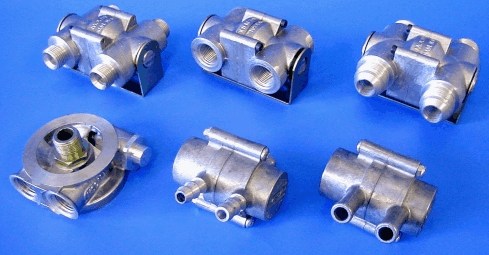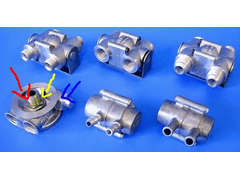

I have a second hand oil cooler sandwich plate. It has what looks like some sort of valve incorporated into it's design (spring and ball affair).
Does this sound like a non return valve or could it be a thermostat. Other sandwich plates I have seen don't have anything like this.
?
If there is just a ball and spring it sounds like a pressure relief valve - A thermostat is usually a wax canister affair...
as monkey face says. now depending on the design, there will be a cylinder inside a coil spring; you can the the part that I mean it is at the top
right corner of the part that is in tit the lower left hand corner below.

Sounds like an excess pressure release valve - like you'd have on the oil pump??
I took another look this evening at the sandwich plate looks very like the one indicated below (red arrow). It has the extra housing on it (blue
arrow) behind which is a spring pushing against a metal canister of some sort (it looked like a ball on first inspection). With the canister pushed
back by the spring it looks like oil can flow from one side of the sandwich plate to the other (yellow arrow). However with the spring compressed the
oil will be redirected through the oil cooler. I'm fairly certain it is a thermostat but I stand to be corrected.


Rescued attachment oilstats.jpg
Yep Ive got one on my R1 engine and its a thermostat so the oil only gets directed through the cooler (ie through the outlet hole) when its hot.
[Edited on 1/10/06 by ChrisGamlin]
yep 16v vauxhall sandwich plate is the same
Have that particular mocal plate which I use. It allows for a flow of 10% of the oil to the cooler until the oil temp reaches 80 degrees and then opens fully to allow 100% flow, the idea is that a fully sealed system wouldn't allow a gradual change rather than a sudden cold rush of oil out of the closed system at once.